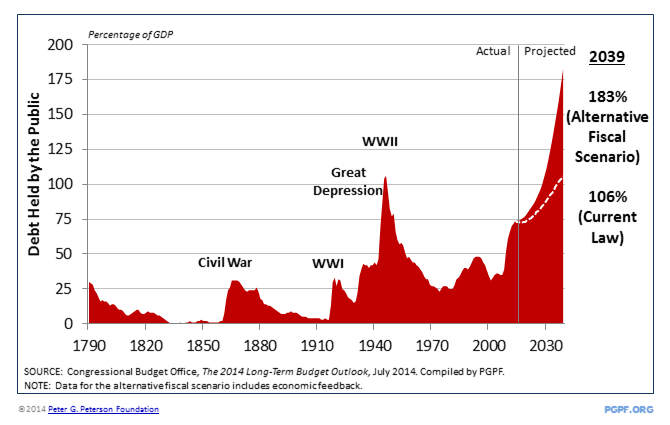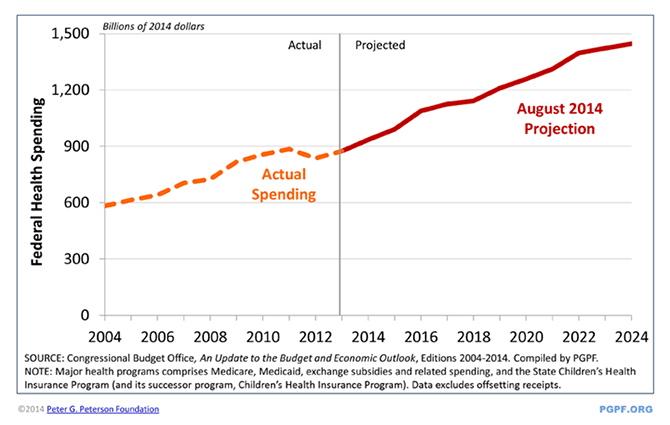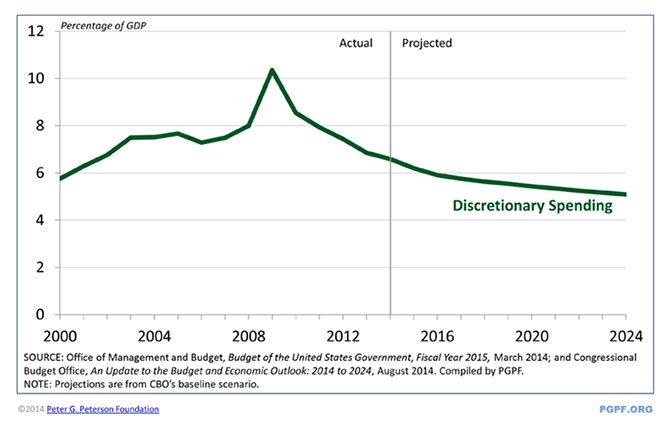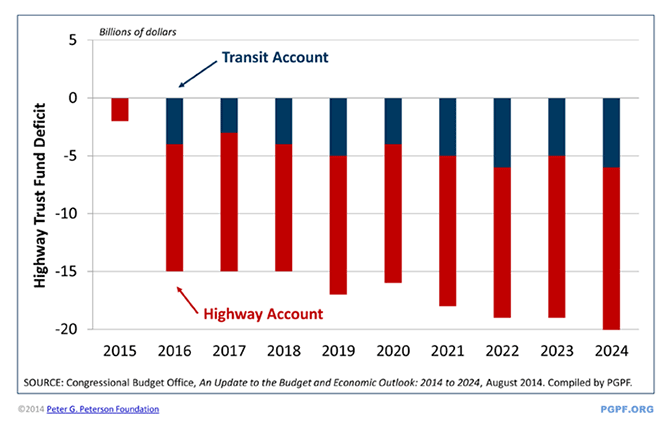You are here
Welcome Back, Congress

As the August recess concludes, the House and Senate return to a to-do list filled with important fiscal and economic deadlines. Lawmakers face a range of key issues in the brief legislative session before Election Day, during the “lame duck” session following the election, and next year.
The Latest Fiscal Outlook
As lawmakers return to the Capitol, our fiscal outlook remains unsustainable. Last month, the Congressional Budget Office (CBO) released new budget estimates which show that federal debt held by the public will reach 74 percent of GDP at the end of this fiscal year. The report states that this level is "more than twice what it was at the end of 2007 and higher than in any year since 1950." Although the debt-GDP ratio is projected to decline slightly over the next couple of years, that good news will be short-lived. By 2019, federal debt is projected to begin rising again and by 2024 it will reach 77 percent of GDP — above its current level.
CBO warns that growing debt will have an economic cost by crowding out both private and public investments in our future. According to CBO, interest costs on the debt are projected to total $5.2 trillion over the next 10 years under current law. By 2023, they will exceed what we have historically spent on R&D, education, and nondefense infrastructure, combined.
Even greater problems arise soon after that. CBO projects that debt will rise to 106 percent of GDP within 25 years under current law and could soar to a staggering 183 percent of GDP under less optimistic assumptions.
U.S. debt held by the public is on an unsustainable path

Healthcare spending constitutes a significant share of the current budget and the projected growth in spending. While CBO now projects that Medicare will not grow as fast as previously estimated, total spending for healthcare continues to climb as baby boomers become eligible for Medicare, more people gain subsidized health coverage through Medicaid and the insurance exchanges, and overall prices continue to increase. Despite the recent slowdown in healthcare cost growth that CBO has incorporated into its latest estimates, CBO still projects that spending for major healthcare programs in 2024 will be more than one third of total noninterest spending and twice what the government spent in 2013.
CBO’s projections of federal spending on major health programs have improved, but are still on a sharp upward path

CONGRESS' TO-DO LIST
As Congress returns, lawmakers face a to-do list filled with important legislative deadlines in a short period of time. There will only be ten days left on the House calendar before the end of fiscal year 2014, and there are only three months left in the 113th Congress, including the "lame duck" legislative session following Election Day on November 4.
Here’s a look at the top issues affecting America’s fiscal and economic future that lawmakers will have waiting for them through the end of the year, as well as what awaits the new Congress in 2015 and beyond.
Appropriations for FY 2015
The federal government’s new fiscal year begins on October 1, yet Congress has not passed any of the 12 appropriation bills that are needed to keep the government operating next year. Although the total level of spending for these discretionary programs is constrained by caps that have been agreed to and enacted into law, annual funding of any individual program requires passage of an appropriation bill.1
Many observers expect that lawmakers will be unable to meet the October 1 deadline and once again will resort to passing a continuing resolution (CR), a temporary measure for keeping the federal government open.
- Discretionary programs face a spending limit of $1,114 billion in FY 2015.2 That is lower than for any year since 2003 (after adjusting for inflation).
- Nondefense spending in 2015 will have to be cut by $21 billion from its 2014 level, forcing lawmakers to make tough decisions about competing domestic priorities. If lawmakers exceed the cap and don’t make other changes in law,3 automatic across-the-board reductions — sequestration — will reduce total spending to the level of the caps.
- Spending on defense programs will be roughly flat at $608 billion in 2015 — about a $2 billion increase from its 2014 level.
- These spending caps are in place through 2021 and will reduce discretionary spending to a historically small share of GDP.
Budget authority for discretionary spending is projected to decline steadily as a percentage of GDP

Expired and Expiring Tax Provisions
According to Congress’s Joint Committee on Taxation, 55 tax provisions expired at the end of December 2013. Another 6 will expire by the end of December 2014. In the past, lawmakers have routinely extended many of these provisions, which include items such as the tax credit for research and experimentation, as well as more obscure provisions such as deductions for motorsports entertainment facilities. Lawmakers can extend these provisions and apply them retroactively, but they must do so before the Internal Revenue Service sends out tax forms and filing instructions in January 2015.
- Extending all the expired (and expiring) provisions over the next 10 years would lower revenues by about $900 billion relative to current law. Under current pay-as-you-go (PAYGO) budget rules, lawmakers would have to pay for the cost of extending those provisions by either raising other taxes or reducing spending on mandatory programs.
- While Congress waits to act, those who would benefit from extension of expired credits are left guessing about whether they will be able to claim those benefits, weakening the intended impact of providing the tax breaks and undermining confidence about the current state of tax policy.
Debt Ceiling Back in Play
The debt ceiling, which governs the total amount of Treasury debt that can be outstanding, was suspended in February 2014. It will be reinstituted on March 16, 2015. If lawmakers do not act, within weeks thereafter, the Treasury will not have sufficient funds to pay the government’s obligations. This could result in a technical default, which would be a serious, self-inflicted wound to the economy.
- By law, Treasury cannot borrow in excess of the debt limit and could default on some of its obligations if the ceiling is not raised in time. In a 2013 study commissioned by the Peter G. Peterson Foundation, Macroeconomic Advisers estimated that even a brief default could push the unemployment rate to a peak of 8.5 percent — equivalent to 2.5 million jobs lost.
- The debt ceiling is a dangerous and ineffective tool for making policy and controlling federal spending. If lawmakers’ goal is to limit spending, they should change the laws that permit that spending, not put the full faith and credit of the United States government at risk by threatening default. Raising the debt ceiling only enables the Treasury to meet the commitments that lawmakers have already made by enacting prior legislation into law.
Medicare Doc Fix Still Needs Fixing
Without action by April 1, 2015, physician reimbursements under Medicare will be cut by about 24 percent. The cut stems from a provision in current law — the so-called sustainable growth rate (SGR) formula — that was originally intended to slow the growth of Medicare spending. In every year since 2003, policymakers have waived the SGR so now the gap between the formula-determined payment rate and current payment levels has grown. Because the payment cut is built into CBO’s projection for Medicare spending, future Medicare spending is likely to be higher than the projected levels.
- If physician payment rates were cut to the SGR formula level, Medicare patients could likely have difficulty finding physicians to treat them.
- Failing to develop a long-term “doc fix” is disruptive and creates unnecessary uncertainty about how much Medicare will pay physicians.
- Waiving the SGR increases Medicare spending — $131 billion over 10 years — and PAYGO rules would require that those costs be offset.
- A well-designed, long-term solution could improve incentives for physicians to provide better-coordinated and higher-quality care to patients, eliminating delivery of unnecessary, ineffective, and wasteful procedures.
Highway Trust Fund Runs Dry Again
Although policymakers managed to pass a stopgap measure to avert a funding crisis in August 2014, their solution will last only until May 31, 2015. At that time, funding for surface transportation projects will again run short, just as summer construction on the nation’s infrastructure gets underway.
- Financing for surface transportation has historically been based on motor fuel and other related taxes. With greater fuel efficiency and people driving fewer miles, gas tax revenues have not kept pace with the needs of building and maintaining highways and mass transit. Since 1993, lawmakers have not raised the gas tax but instead have transferred funds from the general fund to the Highway Trust Fund. However, those transfers are not additional resources for the government. Moreover, the absence of stable financing for highways and mass transit complicates planning and could increase costs due to interruptions in construction schedules. For more about the Highway Trust Fund, see our explainer.
From 2015 to 2024, the transit and highway accounts are projected to face a total shortfall between dedicated receipts and spending of $157 billion

The FY 2016 Budget
The Bipartisan Budget Act of 2013 resolved disputes about discretionary spending levels for fiscal years 2014 and 2015. But it did not resolve issues about FY 2016 funding levels. In spring 2015, lawmakers will have to put together the FY 2016 budget. The Congressional Budget Act sets up a process for the House and the Senate to establish overall spending, revenue, deficit, and debt levels and to manage the many pieces of legislation that collectively form the budget. However, Congress has not adopted an actual budget resolution since 2009.
- The failure to agree on an overall budget contributes to threatened (and actual) government shutdowns, debt ceiling crises, and disruption of federal operations for federal employees and the public who is served by affected programs.
Social Security Disability Insurance Funding Shortfall
According to latest estimates from the Social Security Trustees, the Disability Insurance program will run short of funding in 2016. Addressing this shortfall without harming the very people the program is intended to help will take time, and lawmakers need to begin working on it now.
- The Disability Insurance program was designed to provide financial help to individuals and their families who are below the retirement age and unable to work. Financing for the program has not kept up with benefit claims. Without reforms, the program’s 11 million beneficiaries face a 19 percent cut in benefits in 2016, with deeper cuts thereafter. While the disability program is a more immediate concern, according to its public trustees, the overall Social Security program faces similar shortfalls in the future, and is in need of strengthening to make it sustainable.
Conclusion
Lawmakers have made little progress towards putting a plan in place that will support our economy and stabilize the trajectory of our long-term debt. In fact, since April 2014, the legislation that has been enacted has had the opposite effect, slightly increasing deficits over the next ten years.
Changes in CBO’s baseline projections of the deficit since April 2014
Billions of dollars
|
Changes to
Projections of the Deficit |
2014 | 2015 | 2016 | 2017 | 2018 | 2019 | 2020 | 2021 | 2022 | 2023 | 2024 |
10-Year Total: 2015-2024 |
|---|---|---|---|---|---|---|---|---|---|---|---|---|
| * | -4 | 1 | 4 | 3 | 1 | * | -1 | -3 | -4 | * | -4 | |
|
Economic
|
-13 | -31 | -25 | 20 | 34 | 22 | 21 | 17 | 13 | 5 | -5 | 69 |
|
Technical
|
-2 | 35 | 4 | 23 | 30 | 38 | 46 | 43 | 43 | 47 | 48 | 357 |
|
Total
|
-14 | * | -20 | 46 | 67 | 61 | 67 | 58 | 53 | 48 | 43 | 422 |
SOURCE: Congressional Budget Office, An Update to the Budget and Economic Outlook: 2014 to 2024, August 2014. Compiled by PGPF.
NOTE: * = between -$500 million and $500 million. Negative amounts reflect increases to deficits; positive amounts reflect reductions to deficits. Data reflects changes to CBO’s baseline projections of the deficit since April 2014.
In the legislative days remaining before the 113th Congress adjourns, there is much urgent work to be done to put the nation on a more sustainable and predictable path, now and in the future.
The math is simple and the consequences of inaction are clear. Delaying action just narrows our options and makes the required reforms more difficult. Working toward a comprehensive, bipartisan plan to address our long-term fiscal challenges is the best way to secure our economic future and protect vital programs for those who need them most.
1The statutory caps were created by the Budget Control Act of 2011 and subsequently amended by the Bipartisan Budget Act of 2013. (Back to citation)
2These numbers include capped discretionary spending and the projected adjustments for emergencies and overseas operations in Iraq and other countries. For FY 2015, budget authority is projected to be $608 billion for defense programs and $506 billion for nondefense programs. (Back to citation)
3Lawmakers could avoid sequestration by raising the caps or by providing a credit against the caps for additional reductions in mandatory spending (as they did in 2014). (Back to citation)
